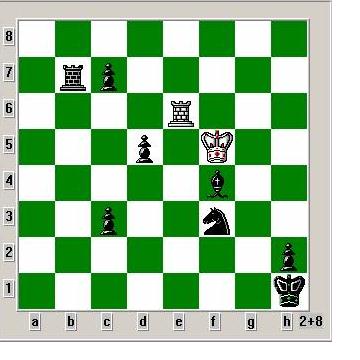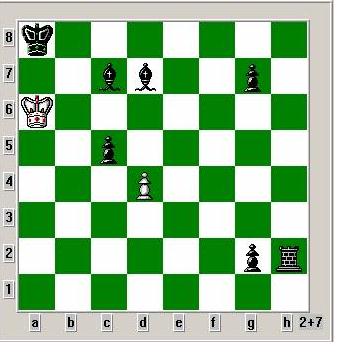Lubomir URSTA
| Help-direct-mate
Lubomir URSTA |
Visitor No. |
Such a method contains first a 'help-part' ('performs several first half-moves which seem the best for him') and then a 'direct-part' ('solves a shorter direct problem').
Thus the idea of help-direct-problems was born: in the first part white
and black help each other to reach a position, when black cannot prevent
from n-mover. There is a direct analogy to a standard helpmate, where white
and black help each other in the first part so that black cannot prevent
from 'one-mover' (in the last half-move of white).
There is also an analogy with an existing type of the problem: help-self-mate,
where white and black help each other to create a one-mover selfmate in
the last move (though there is no reason to restrict the selfmate to just
one move).
The definition of the help-direct-problem is the following: in
help-direct-mate Hx-y# black starts to move, and x moves (minus one half-move)
black helps white to reach a position, when (white moves, and) black cannot
prevent from a standard y-mover.
At the same time, the initial position must not soluble as a standard
helpmate which has less halfmoves than a help-direct-mate.
Examples hopefully help to clarify the idea:
In H2-2# (3.1.1.2#) black starts, and after a next move of white and
black there should be a standard two-mover on the board. At the same time,
the original position must not be soluble as a standard H#2. 3.1.1.2# says
that the help-part contains three ways how to reach any final two-mover.
In the help-part during the first three half-moves the black pieces
must be cleaned-up and white pieces must be setup so that the black ones
have no possibility to make troubles to the white ones in the final two-mover.
In H3-2# (2.1.1.1.1.2#) it is similar, just the help-part is two half-movers
longer and there are only two solutions. The initial position must not
be soluble as a standard H#3.
| Lubomir URSTA | Lubomir URSTA | ||||||||
| original | original | ||||||||
 |
 |
||||||||
|
|
| 1.Rb5 Kxf4 2.Rc5 Kxf3
1.Bc1 Kg4 2.Bb2 Kxf3 1.Nd4 Kxf4 2.Nb5 Kg3 |
1.Bf5 d5 2.Bh7 d6 3.g6 dxc7
1.Bf4 dxc5 2.Bh6 c6 3.g5 cxd7 |
As you can see from the previous problems, the contents of the help-parts is poor and the contents of the direct-parts is zero. Nevertheless, I believe, that real composers will be able to compose a help-direct-problem to be able to be called a problem.
That is why I'm opening a composition competition in help-direct-problems. Those may be mates, stalemates, or other calls of any length (e.g. help-self-mate, when a selfmate part is longer than one move). All fairy-pices, fairy-conditions, or even a slight changes in the problem definitions are allowed. Please send problems to: Lubomir URSTA, Drimlova 2513, 155 00, Praha 5, Czech Republic,or to: lubos.ursta@oracle.com. The chief arbiter is Michal Dragoun, deadline is November 30th 2004. Winners will enjoy small prizes. Information about the competition you can find on http://www.ursta.com/chess/problems/hdm/intro_en.htm or simply on www.ursta.com
One more important thing. I do not know any solving program that could be able to test correctness of help-direct-problems. So please send problems without verification.If we find any incorrecntness, we will send you the problem back for a correction with an explanation. If you have any possibility to test correctness of help-direct-problems, we will be thankful for any info.
At the end I have to mention (with a kind permission of the author)
the classical analogy between chess problems and a life. Many of
you know how Mirek Henrych describes the types of chess problems:
- a direct problem is like a game with a friend. We both try to win.
- a helpmate is like a game with a child. We help the child win.
- a selfmate is like a game with a wife. We make her win so that she
has to be kind to us even though she does not want to.
There were Mirek Henrych's comparisons. And I'm adding:
- a help-direct-mate is like an education of a child. We spoil, spoil,
and when we realize that the child is spoilt too much, it is too late for
education.
The competition results
| Add a Message or a Chess Problem | |
| Back to Lubomir URSTA's homepage |
Last update: November 11th 2005